| |
|
LETTER FROM JERUSALEM
Olmert's optimism on the eve of the Annapolis conference mystifies 'realists'
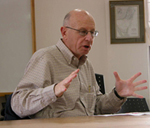 By Ira Sharkansky By Ira Sharkansky
JERUSALEM—Every once in a while there is a speech worthy of comment. Yesterday Ehud Olmert gave one of those.
Condoleezza Rice and Tony Blair were the important people in the ballroom of the King David Hotel. Along with them were two hundred or so of the rich or well known.
Portions of the speech worth ridiculing were Olmert's claim that he was operating in the spirits of Yitzhak Rabin and Ariel Sharon. It was the 12th anniversary of Rabin's assassination, with the atmosphere heated further by being the day of the brit mila (circumcision) of the assassin's son. Sharon is the man who paved the way for Olmert to become prime minister.
Both Rabin and Sharon were all over the map politically. Part of their charm was their unpredictability. It is possible to cite each of them in behalf of virtually anything. Rabin cannot rise from the dead to contradict those who claim him in support of their latest idea, and it is unlikely that Sharon will wake from his 22 month long coma, give a quick reading of the newspapers, and announce his posture on what Olmert is saying.
The American equivalent would be George W. Bush claiming to be operating in the spirits of George Washington, Abraham Lincoln, Franklin Roosevelt, John Kennedy, and Ronald Reagan. He would not quote his father in order to avoid the possibility of a family embarrassment.
Mahmoud Abbas would claim the blessings of Salah al-Din and Yassir Arafat, Allah, and Mohamed, with Jesus Christ thrown in for the benefit of the half dozen or so Christians who survive in Palestine, plus the many more Christian clerics who applaud whatever the Palestinians do.
There were two points in Olmert's speech that warrant serious consideration.
One is his optimistic approach to conversations with Palestinian leaders and the Annapolis conference. He said that he respects his negotiating partners, and expects to reach an agreement that will be appropriate for both Palestinians and Israelis. Initially there will be a formulation of principles, and then negotiations about details that could be completed within a year.
The second point worth noting was the often-repeated Israeli mantra that Olmert will achieve a solution of two states for two people: Palestine for the Palestinians and Israel for the Israelis.
There are important code words in this simple message. They become apparent when compared to the Palestinian mantra: a two state solution.
The code in their formulation is that Palestine will be for the Palestinians, and Israel will be for the Israelis and the Palestinians. The Palestinians in Israel will be the refugees of 1948 and their descendants (and maybe those who left in 1967 and later) who will return to their homes.
These differences are a large part of what lies behind the warnings which we hear are expressed by Israelis and Americans to each other: that there remain chasms wide and deep, and perhaps unbridgeable between the Israeli and Palestinian positions.
It was interesting, and perhaps instructive to hear Olmert's optimism. It is too early to chill the champagne.
Sharkansy is professor emeritus of political science at Hebrew University



THE JEWISH CITIZEN
Shanghai Jews' experiences varied
depending on their countries of origin
 By Donald H. Harrison By Donald H. Harrison
SAN DIEGO—A Jew who escaped from Nazi Germany to Shanghai reflected on a time during World War I when her father fought in the German army against the French. Confronted by a young French soldier, he fired his weapon as the French soldier fired his. He was wounded, but the French soldier’s wound was far more severe. In horror, the father listened as the French man intoned the “Shm’a Israel” prayer as he lay dying. The man her father had killed—and who had tried to kill him—was a fellow Jew.
The story was retold in Shanghai Ghetto, a film by Amir Mann and Dana Janklowicz-Mann. The accident of nationality also was an important factor in the differing fates of Jews who lived in Shanghai during World War II, a pair of panelists made clear following the showing of the documentary today at Tifereth Israel Synagogue.
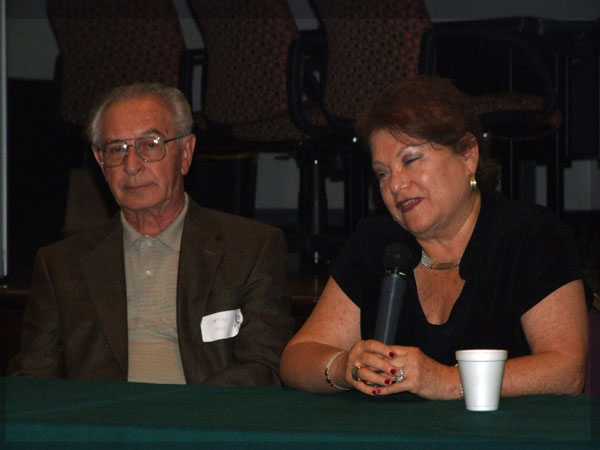
Guenter Cohn and Ella Cashuk remember Shanghai
Ella Cashuk, whose parents had immigrated to China from Russia— first to the border city of Harbin and later to Shanghai—lived a life of privilege, free from restrictions throughout the war. Although Russia was a U.S. ally in the war against Germany, it did not declare war on Japan until after the U.S. dropped the atomic bomb in 1945—a short time before Japan’s surrender. Russian nationals, Jewish or otherwise, therefore were considered neutrals by the Japanese and treated as guests.
On the other hand, American and British nationals, whose countries were at war with Japan, were confined as enemy aliens. What was true of the British also was true of people who came from countries in the British empire, such as Iraq. The first wave of Jews to come to Shanghai in the late 19th century had been Baghdadi Jewish merchants, some of whom became quite wealthy, and were major factors in the build up of Shanghai’s economy. Once the war started however, they were treated as enemies.
The third group of Jews in Shanghai were central Europeans who fled the Nazis. Guenter Cohn, who had immigrated from Germany as a child to Shanghai, initially lived in the Chinese city’s French Concession, but on May 16, 1943 his family was moved to a ghetto in the Hangkew portion of Shanghai. The Japanese relocated the Jews to please their Nazi German allies, but the Japanese never embraced the Nazi campaign of genocide against the Jews. Even the “ghetto” to which Jews were forced to move was a relative term. Hangkew was not like the Warsaw Ghetto, which people couldn’t leave. There were not even any fences. Rather it was a poor neighborhood where German Jews were required to live under the control of Japanese overseers, including a commandant named Goya who fancied himself the “king of the Jews” and was brutal to adults yet kind to children.
In the documentary, the story was told of one Jewish resident of Hangkew who figured out how to play to Goya’s ego. He put on a top hat before getting in line to seek a pass from Goya. At first Goya was suspicious, asking if the man were making fun of him. No, said the man, he always wears a top hat when he calls upon a dignitary. Goya was so delighted he not only issued the man the requested pass, but thereafter regularly let him go to the head of the line.
Cohn had his own story about the mercurial Goya. He watched Goya order the beating of butcher standing in line in front of him, but “when my turn came, Goya was as nice as he could be.”
After the British and American Jews were interned, it fell to the Russian Jews to look after their co-religionists. Cashuk remembered that her father , a banker, sent as much aid as he was allowed to the refugees, many of whom were destitute. Her grandfather, who owned a kosher delicatessen, sent food.
But for the most part, her life was very different than those of the refugees, Cashuk said. Her parents were wealthy enough to have separate governesses for each of their two children, and on one occasion when a brit milah was celebrated in their large apartment, it was big enough to seat 200 people for lunch. Had it not been for the fact that the Communists under Mao Zedung took over the country in 1948, her family happily would have remained in China. Instead they initially emigrated to Israel
Although Cohn’s family and another family were able to purchase and divide a property between them in the ghetto, it was far removed from the luxury of Cashuk’s childhood. Without flush toilets, the two families used “honey buckets” which were not emptied more often than weekly, as Cohn remembers it.
Nevertheless, “we never knew we were poor,” Cohn said. “I had a car—a chair with a blanket over it—and it was also my airplane.” Occasionally, the family would troop over to a housing complex run by Jewish relief agencies, “where we could take a community shower.”
The panel presentation was jointly sponsored by the Men’s Club and the Sisterhood at the Conservative synagogue, which serves as home base for the New Life Club of Holocaust Survivors.
< BACK TO TOP


HONORABLE MENSCHEN IN SPORTS
Jewish owners brought pro basketball to San Diego County, but couldn't sustain it
By Joe Naiman
LAKESIDE, California— The National Basketball Association's 2007-08 season is under way, which if you're counting is the 24th consecutive season without a top professional team in San Diego County and the seventh straight season without any professional men's team in San Diego County. In the past, however, San Diego has been home to National Basketball Association and American Basketball Association teams,and three Jewish owners were responsible for bringing top-level pro basketball to San Diego.
Bob Breitbard has made numerous contributions to San Diego sports. He was a freshman college coach at San Diego State University, a baseball coach at Hoover High School, and the founder of the San Diego Hall of Champions. He was also the owner of the San Diego Rockets of the National Basketball Association and the San Diego Gulls of the Western Hockey League,and he was also the original operator of the San Diego Sports Arena.
The Breitbard family income was derived from a cleaning and dyeing business. That gave Bob the
financial resources to bring pro sports to San Diego.His first application for team ownership was to the
Western Hockey League.
In 1963 the WHL granted San Diego a franchise for the 1965-66 season contingent upon an arena being in place. Glacier Gardens, which hosted the San Diego Skyhawks in the earliest years of the WHL, was no longerstanding. The San Diego Coliseum hosted boxing, professional wrestling, and roller derby contests but did not have ice capability. At the time San Diego was awarded the
conditional WHL membership, the plans for the new sports arena involved a 12-acre site at Federal and Euclid.
Since there's a bus line whose stops include that intersection as well as the ones by Hardy Elementary
School and Horace Mann Junior High School, chances are I would have been on that bus frequently to attendbasketball and hockey games had that site been selected.
Fortunately for my academic work, Point Loma was chosen as the site for the San Diego Sports Arena.
The City of San Diego owned the land while Bob Breitbard became the original operator.
The Sports Arena wasn't finished in time for the 1965-66 season, but the Gulls began play in 1966-67. San Diego thus had a new arena seating over 12,000, and the National Basketball Association was interested in an expansion team in San Diego. Bob Breitbard had that same interest, and the
San Diego Rockets began play in 1967-68.
Bob Breitbard wasn't a pauper, but he wasn't a billionaire either. Financial conditions caused the
City of San Diego to give control of the Sports Arena to Peter Graham. The Rockets were rumored to be moving to Omaha before eventually relocating to Houston for the 1971-72 season. After the 1973-74 season Grahamwelcomed the relocation of New Jersey's World Hockey Association team to San Diego, and the arrival of the Mariners meant the end of the original Gulls.
Bob Breitbard continues to be an icon in San Diego sports, but he hasn't owned a professional sports team since the WHL Gulls were replaced.
Leonard Bloom, an orthodontist when he wasn't active in the San Diego sports community, was involved in the House of Ice rink in La Mesa, which hosted Gulls practice as well as amateur hockey, figure skating, and recreational ice skating. Bloom sought a replacement pro basketball
team for the Rockets, and since basketball had two major leagues at the time the American Basketball Association gave him what the National Basketball Association didn't. The San Diego Conquistadors were granted admittance to the ABA for the 1972-73 season.
Bloom now had an ABA team but no arena. Peter Graham hoped to bring another NBA team to the Sports Arena and didn't want to tarnish the building's reputation with an ABA franchise. Bloom lived in Alvarado Estates and his children attended Hardy Elementary School, which is not only the
school I attended but also the school adjacent to San Diego State University. The SDSU athletic department was willing to rent Peterson Gym to the Conquistadors, and the Q's first season saw home games played in an arena seating approximately 2,500. In addition to the small size, Peterson Gym was also primarily the Aztecs' facility, and in 1973-74 Bloom and the Conquistadors avoided conflict
by playing home games at Golden Hall in the San DiegoCommunity Concourse.
Although the Conquistadors were playing on the same premises as City Hall, Bloom never asked the City of SanDiego for an arena. He also didn't ask the City of Chula Vista for financial contributions for a sportsarena, but he planned to build a 20,000-seat arena in Chula Vista. While the City of Chula Vista would not have borne the cost of building the arena, the citizens would have dealt with the additional traffic, and in November 1973 a ballot measure to authorize the building of the sports arena in Chula Vista was narrowly defeated.
Graham finally allowed the Conquistadors to play in the Sports Arena for 1974-75, but Bloom had sustained heavy financial losses. The Conquistadors were renamed the Sails for the 1975-76 season but only played eleven games that year before folding.
Irv Levin lived in the Los Angeles area, but the highest levels of the Louis Rose Society for the Preservation of Jewish History, a group focusing on San Diego Jewish history, have informed me that he is eligible for the society's honor roll for his contributions to San Diego. When the National
Basketball Association's Buffalo Braves became available for relocation, Levin brought the team to San Diego and renamed it the San Diego Clippers.
The Clippers played their first San Diego Sports Arena season in 1978-79. They finished with a 43-39 record, but in the days when only six teams from each conference reached the playoffs they were denied post-season participation. Levin sensed opportunities for the Clippers to improve.
Unlike some teams who were torn apart because their owners didn't want to spend money, the Clippers were decimated because Levin was willing to spend top dollar. He signed Bill Walton to a multi-year contract worth millions of dollars. There was just one problem. Under the NBA's free agent compensation system at the time, the signing team and the player-losing team submitted
proposed compensation for the free agent. In the event of a disagreement, the NBA commissioner made the decision.
Commissioner Larry O'Brien determined that appropriate compensation for Walton was two starters, two first-round draft choices, and cash. So not only was Irv Levin out the salary money when Bill Walton was injured for much of his Clippers career, but he was also out the 1978-79 players and the future draft picks. The Clippers never again posted a winning record before leaving San Diego.
In 1981 Levin's wife was killed in an automobile accident. Levin decided to sell his basketball team
and made the sale to another Los Angeles owner who moved the team to the Los Angeles Sports Arena in 1984.
Professional basketball still has Jewish owners, and San Diego basketball fans still have memories of
Jewish owners of local teams. The memories are all San Diego has of pro basketball right now, and the Jewish owners made significant contributions to those memories.
< BACK TO TOP



DANCE: THE JEWISH CONNECTION
City Ballet's 15th season in San Diego provides several views of classical ballet
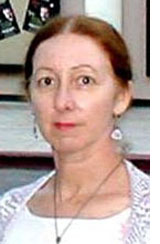 By Sheila Orysiek By Sheila Orysiek
SAN DIEGO—At the Joan B. Kroc Theatre on Nov. 3, City Ballet opened its fifteenth season with a well balanced program of classical ballet seen through several windows of style.
Igor Stravinsky’s Firebird has a special place in the history of the ballet. The ravishing music was the young composer’s first ballet score commissioned in 1910 by the legendary Impressario Serge Diaghilev, the founder of the Ballet Russe which changed and gave birth to ballet as we know it. Elizabeth Wistrich, resident choreographer of City Ballet of San Diego, steps into the line of luminous names who have created dance for this score: Fokine, Balanchine, Lifar, Robbins, Bejart, Neumeier, Tetley, Taras, Scholtz and Wheeldon.
The story is based upon a Russian fable in which a prince captures a firebird who gives him a red feather as the price of her release. When the prince in turn is captured by an evil spirit with the threat of being turned into stone, he uses the magic feather to summon the firebird who destroys the evil spirit. In the midst of his wanderings the prince has come upon a group of princesses, falls in love with their leader, the Tsarina, whom he marries.
The role of Firebird is difficult to dance because she is never human, doesn’t move as a human would, nor reacts as such. The top of the body, hands, arms and head - flicker - flash - with small abrupt bird like movements, while at the same time the rest of the body executes the classical ballet vocabulary with its demands for smooth transitions. Therefore, the body is bifurcated - one half a bird, the other half a human ballet dancer. Janica Smith did both halves well, and brought it together as a whole: a fabled bird. Of special note was her series of bourrées across the entire stage which rippled and flowed as well as I’ve ever seen done. She needs to smile when taking her bows - she deserved the applause.
Partnered by Taurean Green, who after an initial momentary case of nerves as he supported her turns, quickly settled down and gave a convincing performance of the prince: Tsar Ivan. He was at his best while dancing himself, but was not helped by the dark foot coverings from mid calf down. Against a dimly lit stage, with dark trees as a background, some of his dance was difficult to discern. I admit to a personal dislike of dressing male dancers in dark clothing against dark backdrops. Likewise the evil spirit’s minions - were also in dark one piece hooded body suits with streamers - at times difficult to see.
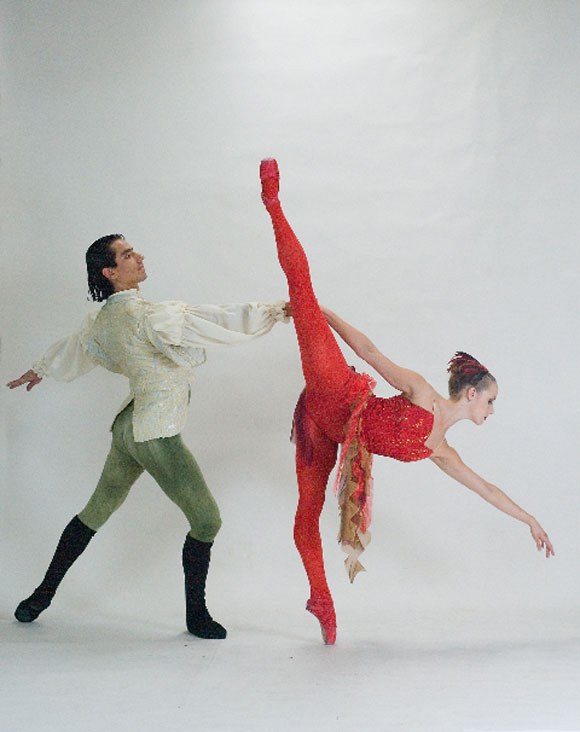
Girardo Gil and Janica Smith in The Firebird (Photo by Dale Stokes)
The evil spirt - Kaschei - danced by Gerardo Gil while well done, was nasty rather than scary. The choreography for his role was classically based and therefore intrinsically beautiful rather than frightening. Again, he too, was in black. White layered empire style dresses for the princesses were lovely, but more flattering to some - less so for others. The choreography for the princesses had echoes of Russian folk dance with an occasional hand behind the head, or an almost Petrushka-esque use of the full foot.
This brings me to the petit allegro sequences of glissade jeté for the ensemble of princesses - a deceptively simple but actually difficult combination to perform well. It is because these two steps are so much a part of the dancer’s vocabulary - almost from the first ballet lesson - and so often coupled - that they tend to be skimmed over - or through - rather than fully exploited. If the glissade doesn’t finish in a true fifth position, heels firmly on the floor, then the small jump into the air (the petit jeté) - with both feet fully pointed - is blurred. The sparkle is lost.
The costumes for the finalé - capes - for the Tsar and Tsarina could use a re-think - they are a bit tawdry rather than royal. And while I’m nitpicking, the Firebird could do with a more impressive feather - this one looked more pigeon than magical. Notes in the program stated the proclivity of the evil spirit to turn hapless humans into stone, but I didn’t catch any attempt to present this in the stage action. As the company expands and grows, it might be interesting for the choreographer to consider including this aspect of the story. It would add a layer of magic and drama.
The Spartacus Pas de Deux (music: Khachaturian; choreography: Grigorovich) comes from the full length ballet produced at the height of the Soviet era. This genre typified the demands of the government to further its political ideology. It is important to know that this version of the pas de deux was created for the Bolshoi Ballet - a company world renowned for its full throated bravura technique and presentation. This is dancing in the Big Leagues - a challenge to any dancer.
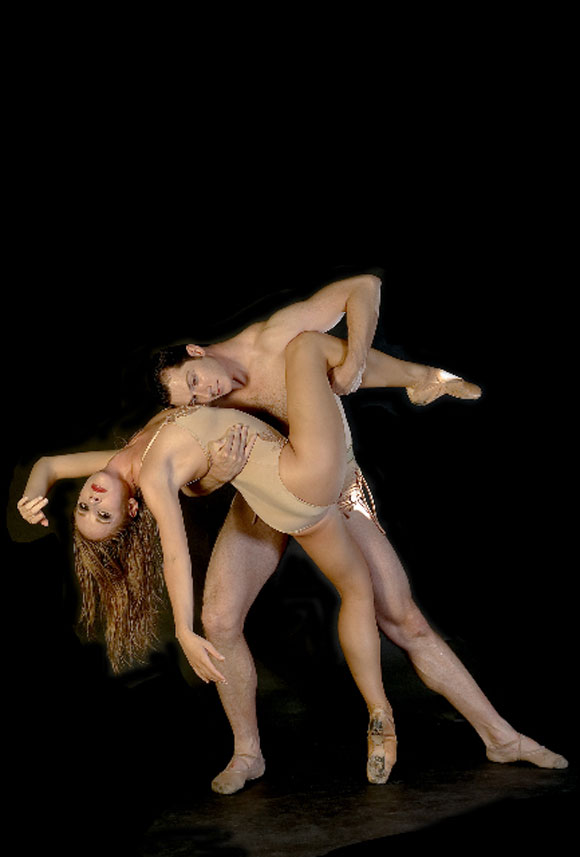
Ariana Samuelsson and Ivan Bielik in Spartacus (Photo by Dale Stokes)
Ariana Samuelsson and Ivan Bielik did the company proud. The choreography is over the top Russian style, with huge complex lifts - all smoothly accomplished; a notch in the belt of any dancer. At the same time, the subject matter - two slaves in love but doomed to eventual death by a consuming Roman Empire - demands dramatic depth. Bielik was a wonderful partner, a despondent but brave slave; however he needs a tad less of the beauty of the Kirov style, and a shade more of the Bolshoi pathos. He has to seem to throw away the technique - hiding it under the skin of an uncouth slave.
It was a beautiful heart reaching performance of a most difficult piece of dance. Bravo/brava to both dancers.
Stravinsky Pieces, choreographed by Wistrich was a nice change of pace - fun, funky, and never to the point of overdone. All the dancers were costumed (by Gillian Metcalf) in various designs of black and white, bits and pieces of white trim and fluff on black and vice versa. Since the stage was brightly lit - black presented no problem. The dancers had fun, especially Lara Bossen with her bright smile - and so did we. After the drama of Spartacus this was a good change of mood.
The Grand Pas de Deux from the full length Flames of Paris (choreographer: Vainonen; music: Asafiev) is another ballet produced to satisfy the Soviet era demand for politically correct ballets. First presented by the Kirov Ballet, it has a great deal of classically structured bravura dancing - with the technical demands one would expect from that fabled company. This grand pas de deux (big dance for two) follows the strict format of entrée and adagio for ballerina and danseur, a variation (solo) for the danseur, a variation for the ballerina and a final coda for both. In some productions a grand pas de deux has more than one variation for each dancer.
Brightly costumed (by Suzanne Jackson) in white tutu, with the danseur in white and pale blue - this ballet flashed with ample opportunity for each dancer to showcase classical bravura technique. Janica Smith and Gerardo Gil rose to the challenge, she with secure fouetté (whipping) turns, every third one a double, and he with a series of space devouring jumps. They were a pleasure to see.
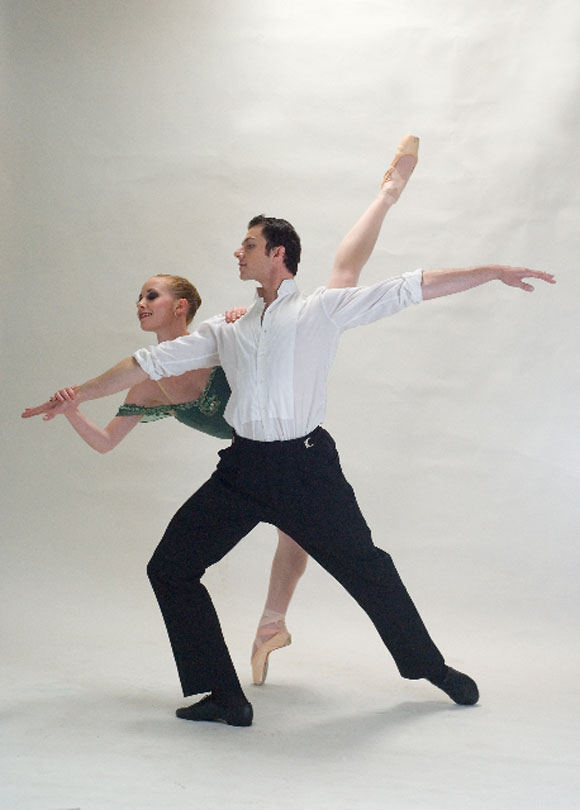
Ariana Samuelsson and Ivan Bielik in Who Cares? (Photo by Dale Stokes)
Balanchine’s Who Cares? uses some of Gershwin’s most loveable music. Ariana Samuelsson’s use of her eyes in The Man I Love was adorable - and Ivan Bielik responded - how could he not? Again, Lara Bossen’s smile is as engaging as her dancing in I’ll Build a Stairway to Paradise. Janica Smith’s fouettés (whipping turns) into chainés (linked turns) was beautifully done.
Did I see some pivots (direction changes) done with weight on the heel? Did Balanchine do this to add to the swivel of his choreography in this suite of dances? Speaking of “swivel” - it was nice to see how the dancers as a whole caught that in the hips - Balanchine’s answer to shouldered épaulement (twist in the shoulders giving the torso an added dimension).
It was plain to see the Company enjoyed dancing this ballet and the pleasure traveled across the theater - every one of the performers a delight. While they all caught the humor, Samuelsson also caught the occasional Suzanne Farrell (Balanchine’s favorite muse) languor; that seeming delay in moving on, that lingering longing.
It is obvious that each member of the Company has been carefully chosen, carefully cast, there are no spear holders just filling a space on stage. Every place has been earned. In September I interviewed Artistic Director, Steven Wistrich, and he mentioned his desire to expand the Company’s horizons and roster to undertake larger challenges. One can only hope it comes to pass.
This was a full evening of exemplary dance - intelligently shaped - filled with challenges - all of them met and then some. While there was a good audience turnout - every seat should have been occupied. The Company is growing with every performance not only in artistry and presentation but also in depth of talent. Wake up San Diego.

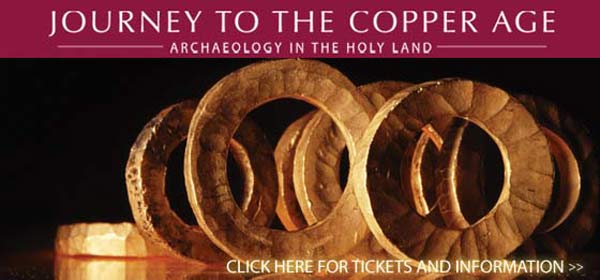
SAN DIEGO JEWISH WORLD
THE WEEK IN REVIEW
• SATURDAY, NOVEMBER 3
Dov Burt Levy in Salem, Massachusetts: "3 wishes from deep inside Red Sox Nation"
Ira Sharkansky in Jerusalem:""Breakthrough in Annapolis? Don't hold your breath that anything will happen"
Dorothea Shefer-Vanson in Mevasseret Zion, Israel: "A trip into my unknown German past"
David Strom in San Diego: "Collection of Chanukah essays stirs memories of family trips and gelt"
• FRIDAY, NOVEMBER 2
Shoshana Bryen in Washington, DC: "Convicting the foot soldiers while giving master terrorists virtual immunity."
Judith Apter Klinghoffer in Philadelphia: "Salah Uddin Shoaib Choudhury, a Muslim moderate, inspires Federation"
Rabbi Baruch Lederman in San Diego: "She took a phone to bed with her and saved the lives of her neighbors."
Rabbi Leonard Rosenthal in San Diego: "The best way to reduce your own troubles? Help others!"
• THURSDAY, NOVEMBER 1
Shoshana Bryen in Washington, D.C. "A Town Meeting at Foggy Bottom"
Rabbi Wayne Dosick in Carlsbad, California: "Some hints for fire victims and their friends from two who went through it"
Larry Zeiger in San Diego: "Monty Python-style riff on the Bible offered at San Diego Rep"
• WEDNESDAY, OCTOBER 31
Donald H. Harrison in San Diego: "Sandy Koufax, Jackie Robinson are role models for this baseball story"
Joe Naiman in El Cajon, California: "Short Track Racecars in Ramona and its owners weather the Witch Creek Fire"
Isaac Yetiv in La Jolla, California: "The fabled Rebbe Hai Tayeb lo-met of Tunisia bests a Jerusalem Talmudist"
• TUESDAY, OCTOBER 30
Garry Fabian in Melbourne, Australia: "Communal lethargy dogs Jewish roof body" ... "Go-ahead for Jewish same-sex unions" ... "Jewish journalist nominated for Walkley Award" ... "Aussie educators link with Israel"
Donald H. Harrison in San Diego: "Ad hoc task force lays traps for scammers in wake of fires"
Ira Sharkansky in Jerusalem: "Swift Swiftian response to Gaza rockets"
• MONDAY, OCTOBER 29
Donald H. Harrison in San Diego: "Rabbis prepare for theological questions about the fires."
Morton A. Klein in New York: "Palestinian agenda dooms Annapolis conference to failure"
Dorothea Shefer-Vanson in Jerusalem: "Scandals, corruption weaken Israel"
David Strom in San Diego: "The danger of substituting political faith for logic"
• ARCHIVE OF PREVIOUS ISSUES
|
|

